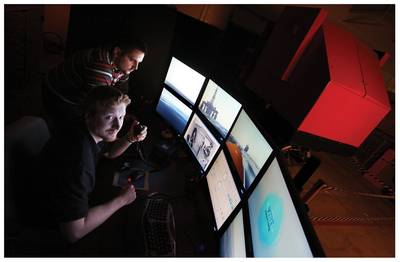Survival Training & The Virtual World
Can Be More Real Than Real World for Survival Training
Citizens are sometimes left wondering how they can comply with the letter of the law. According to the International Convention on Standards of Training, Certification and Watchkeeping for Seafarers (STCW), in order to receive certification, seafarers must be able to demonstrate that they possess critical safety skills that would be required in shipboard emergencies, such as firefighting and lifeboat launching. As an example of such an emergency, Captain Anthony Patterson, President and CEO of Virtual Marine Technology (VMT) of St. John’s, Newfoundland, cites the MSC Napoli—a container ship that had to be evacuated in the English Channel in 2007 due to hull damage. “The convention is clear,” he says. “You have to demonstrate your competence to do this job using real equipment. This is an impossibility, the way it’s normally done, because the risk of injury is too great to train using real equipment.” Capt. Patterson was speaking in St. John’s in late October at Ocean Innovation’s Extreme Survival conference, co-sponsored by the Marine Institute of Memorial University of Newfoundland and the International Association for Safety and Survival Training.
When the Manila Amendments to STCW came into effect in January 2012—the standard for lifeboat training, which had specified the use of real equipment, was expanded to include simulation-based training. As Director of the Centre for Marine Simulation at the Marine Institute, Capt. Patterson was on the project team with Memorial University’s Faculty of Engineering and Applied Science that developed a lifeboat simulator and petitioned the International Maritime Organization in 2008 to consider lifeboat simulation as a viable training option. (VMT was spun out of that project team.) “We asked, ‘Is this a good way for preparing lifeboat coxswains for the real thing, and they said yes,” Capt. Patterson reports. The new STCW standard was developed in 2010 and came into force this year.
Pointing to Chapter 6 of STCW, Capt. Patterson notes that every five years seafarers are obligated to provide evidence to the regulator that they have maintained proficiency in safety skills (refresher training). “How are they going to maintain competency operating in rough seas with helicopters, or extinguishing a fire?” he asks, adding that the responsibility placed on companies in Chapter 1 is also difficult to fulfill using standard training methods. The ship owner is required to ensure that all crew members know how to operate safety equipment and perform emergency procedures before they are assigned duties (familiarization training). “If there’s an incident and the members can’t operate the equipment,” he says, “you as a company are behind the 8-ball. The industry is saying, ‘There’s no way we can afford this.’ Simulation is one of the ways.”
Capt. Patterson sees simulation filling the gap in emergency training because “you can only go so far in your training using real equipment before you run into risk issues, and you have to dilute your training, so you don’t cross the line. The virtual world doesn’t have that restriction.” He adds that since there are no physical safety issues, the operator can allow the system to go into failure mode as a result of a decision that’s been made. “You can let it go to its logical conclusion even if that means an accident,” he says, “because people will learn from it.” Having this latitude to push the envelope in a simulated environment “makes virtual worlds, in some contexts, more real than what you could achieve using real equipment.” An example of this he cites is the training conducted by Wismar University and the Maritime Simulation Centre Warnemuende in Germany on shipboard fire management for RO/RO passenger ferries. “By flipping into a virtual world,” says Capt. Patterson, “seafarers learn to manage an escalating fire. Students say the training is fantastic, and we need more of it.”
Another example is the world’s first freefall lifeboat training facility—co-developed by VMT and Memorial University—that has been operational at the Marine Institute’s Offshore Safety and Survival Centre since September. This type of lifeboat is launched into the water from a downward sloping slipway, as compared to the davit-type lifeboat which is launched from a freestanding deck-mounted structure. Due to the high capital and operating costs a training facility would incur to provide real-life freefall training—plus the human risks involved in using real equipment—this type of training is not available at many facilities. “Imagine the difficulties, the cost, and the risk of dropping the boat during a training,” says Capt. Patterson. Trainees operating the freefall lifeboat simulator experience roll, pitch, yaw, surge, sway, and heave, and practice the procedures for launching the lifeboat, performing once it’s landed on the water, and during sail-away. Regarding the effectiveness of simulation-based training, he refers to a study sponsored by Transport Canada and conducted by the National Research Council in 2010 and 2011 that compared one group that was given traditional seafarer lifeboat training to another group that learned to drive lifeboats in an ice field in a simulator, never having driven a boat before. When the simulator-trained group drove lifeboats in a real ice field, their success rate was 89% compared to 72% for traditionally trained subjects. Capt. Patterson adds that a person receiving simulator training on the launch and sail away can run through the procedures 12 times in an hour, compared to three times with real equipment—substantially more hands-on training time.
The primary measure of success, Capt. Patterson reports, is the trainee’s engagement with the training. “If they’re not happy with it, you revert back to the main problem which is people resisting doing the mandated training because it’s not challenging and boring.” The National Research Council study reported a 38% increase in satisfaction with simulation-based training, compared to standard methods. Cost savings are a lower priority, he adds, even though the cost savings are substantial, citing an 80% reduction in cost compared to the use of real equipment. The latter scenario involves capital costs including a boat, a davit, a safety boat, and waterfront property, plus equipment installation, hiring additional instructors, and maintaining the boat and launching system. When training on a simulator in a specialized facility in a fixed location, he notes that the primary cost is travel, living expenses, and salary offsets, rather than tuition. To dramatically reduce these costs, Capt. Patterson suggests that training facilities begin to use mobile simulators to bring the training to the students. Rather than advocating for simulator training in place of on-board training, Capt. Patterson sees the two training modes as complementary, forming a blended solution.
(As published in the December 2012 edition of Maritime Reporter - www.marinelink.com)














